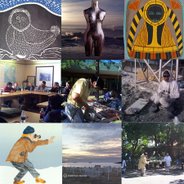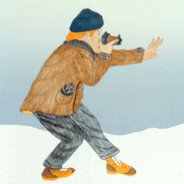
Sunday, November 26, 2006
Saturday, November 25, 2006
Inuit Qaujimajatuqangit
Inuit Qaujimajatuqangit […] is more than a government policy; it is our collective means of interpreting our world. As a theory of knowledge, (IQ) is a set of practical truisms about the interrelationships between nature and society that have been passed orally from one generation to the next. It is a holistic, dynamic and cumulative approach to knowledge, teaching and learning. (IQ) recognizes that one learns best by observing, doing and experience (Okalik 2003)."
An Inuit-centred lexicon of human rights is emerging[1] based on Inuit Qaujimajatuqangit concurrently with the emergence of institutions, their mandates and publications, such as, the Bathurst Mandate (GN 2000), the Clyde River Protocol (Okalik and Kusugak 1999) and the Interviewing the Elders Series (Laugrand, Oosten, and Rasing 1996). Consultations leading to the formation of Nunavut and to the development of a Human Rights Bill[2] (GN 2003), the Government of Nunavut Hansard[3] (Irqittuq 2003) for Nunavut (Amagoalik 2001) also provided invaluable material for understanding the changing teaching, learning and research environment in Canada’s North. Inuit legends such as the Kiviuk epic legend, the legend of the blind boy and orphan boy can be used to illustrate traditional ways in which stories revealed consequences of violating the rights of the disadvantaged and marginalized. A number of videos including those made for and by Inuit were also used in the course to enhance understanding of issues related to human rights in
At this conference Premier Okalik acknowledged the challenges of transforming a society afflicted with inherited social wrongs. Governance for the new territory is based on traditional Inuit values respected for the full weight of the history it reflects, as a proactive means engaging the transition. Inuit culture remained intact until relatively recently unlike other indigenous peoples in
Inuit Qaujimajatuqangit: (IQ) encompasses all aspects of traditional Inuit culture including values, world-view, language, social organization, knowledge, life skills, perceptions, and expectations.'
Aajiiqatigiingniq: the concept of consensus decision-making. (Arnakak 2000).
Ajurnaummat: commonplace Inuktitut expression meaning ‘It can't be helped (Amagoalik 2001).’
Ajurnarmat: change the things that can be changed; accept those that cannot (Coccola and P. 1955; Jenness 1928; Minor 1992; Stefanson 1921; Stefanson 1951).
Inuit Qaujimajatuqangit: (IQ) encompasses all aspects of traditional Inuit culture including values, world-view, language, social organization, knowledge, life skills, perceptions, and expectations (ITK).
Inuit Tapiriit Kanatami: ITK means "Inuit are united in
Inuk Inuit: pl. person
Inummariit: Brody describes the concept of Inummariit (the free Inuk) refers to a person who has overcome physical, emotional and spiritual barriers (Brody 1991:125-45 cited in Minor 1992:104).
Inuuqattigiitsiaqnik: ‘a way for human beings to get along with each other’ (Amagoalik 2001).
Inuuqatigiittiarniq: “the healthy inter-connection of mind, body, spirit and environment.” “The health of
Inuuqatiinniq: interpersonal relationships, community kinship, a collective community process (Under "Healthy Communities" Bathurst Mandate).
Issuma: ability to reason - This “includes a social and group consciousness, taking into account all skills, knowledge and social and environmental influences and relationships Minor 1992:56).”
Issumatuq: In settling disputes the issumatuq could arbitrate a course of action if consensus could not be reached by dissenting parties (Minor 1992).
Makimajjutiit: ‘A tool to be able to stand for oneself" or “a tool against being put down, or oppressed (Amagoalik 2001).”
Nunavummiut: An inclusive term for the people of
Pijitsirniq: or the concept of serving. This principle lays out the roles and relationships between the organization and the people it serves (Arnakak 2000).
Pijunautinngit: ‘a tool you can use to get something’ or ‘an ability to get something’ (Amagoalik 2001)
Piqutiqaqatigiinniq: group communalism (Minor 1992)
Qallunaaq, kabluna, qablunaa non-Inuit
Tukisititsiqqiniq: communication competence (Minor 1992)
Sanaqatigiinniq: collaborative relationships (Minor 1992)
Selected References
Alia, Valerie. 1994. Names, Numbers, and Northern Policy: Inuit, Project Surname and the Politics of Identity.
Amagoalik. 2001. "Introduction: Human Rights Consultation Workshop." in Human Rights Consultation Workshop. Iqaluit, NU: http://www.nunavutcourtofjustice.ca/library/Publications/HumanRight20010429.htm.
[1] Consultations surrounding the formation of
[2] The Government of Nunavut’s Human Rights Act prohibits discrimination on the grounds of race, colour, ancestry, ethnic origin, citizenship, place of origin, creed, religion, age, disability, sex, sexual orientation, marital status, family status, pregnancy, lawful source of income and a conviction for which a pardon has been granted.
[3] “Our rights as Inuit did not seem to be recognized through that Human Rights legislation. It seemed like a waste of time to have to recognize the rights that we already have. Inuit rights and traditions are very strong if we apply it. I can use for example, in Igloolik, an elder had requested some muktaaq while he was still alive and because we were forbidden to hunt Bowhead Whales, when I first became a Member of the Inuit organization, they were just about charged because it was an international regulation that they breached. Mr. Speaker, we realized that the strength of the elders and the strength of the Inuit. If the elder had not requested it then the hunters would have been charged and have to pay a hefty fine. And because we followed with the needs of Inuit, the lawyer was able to win the case and not have them charged, and that is how we realized the strength of Inuit and the elders. We still have that strength. We can still use it, even when it is not in legislation. We all know the issues in our communities and we all know the wrongs that were done to Inuit. As Inuit, we have fought collectively for our needs in 2003 and now we have buildings like these that are for Inuit (Irqittuq 2003).”
Older Version of Selected Bibliography (to be updated)
Berlo, Janet.(1990) "The Power of the Pencil: Inuit Women in the Graphic Arts" Inuit Art Quarterly, Winter.16-26.
Berlo, Janet Catherine. (1995) "Drawing and Printmaking at Holman" Inuit Art Quarterly , Fall.
Berlo, Janet Catherine.(1998) "Drawing (Upon) the Past: Negotiating Identities in Inuit Graphic Arts Production," in Unpacking Culture: Art and Commodity in Colonial and Post-Colonial Worlds, edited by R. Phillips and C. Steiner, Berkeley: University of California Press, pp. 176-191.
Berlo, Janet Catherine.(1998)"Arts of Memory and Spiritual Vision: Plains Indian Drawing Books," in Native Paths: American Indian Art from the Collection of Charles and Valerie Diker, edited by A. Wardwell, New York: the Metropolitan Museum of Art, pp. 10-24.
Berlo, Janet Catherine.(1995) "Our (Museum) World Turned Upside-Down: Re-Presenting Native American Arts," (with Ruth Phillips), Art Bulletin 77 (1):6-10.Blodgett, Jean.(1977) Karoo Ashevak. Winnipeg: The Winnipeg Art Gallery.
Blodgett, Jean. (1978) The Coming and Going of the Shaman: Eskimo Shamanism and Art Winnipeg: Winnipeg Art Gallery.
Blodgett, Jean.(1979)Eskimo Narrative. Winnipeg: Winnipeg Art Gallery.
Blodgett, Jean.(1983) Grasp Tight the Old Ways: Selections from the Kramer Family Collection of Inuit Art. 1 ed. Toronto: Art Gallery of Ontario.
Briggs, Jean. Inuit Women, the Makers of Men.
Butler, Sheila Inuit Art, An Art of Acculturation.The First Passionate Collector: the Ian Lindsay Collection of Inuit Art, Ed. Winnipeg Art Gallery. Winnipeg, 1990. 33 - 4.
Cook, Cynthia Waye. (1993) From the Centre: The Drawings of Luke Anguhadluq. Toronto: Art Gallery of Ontario.
Cornelius, Carol. (1999) Iroquois Corn: in a culture-based curriculum: A Framework for Respecting Teaching About Cultures. Albany: State University of New York Press.
d'Anglure, Bernard Saladin. Inuit Studies/Etudes Inuits.
Dewar, Patricia.(1994) "You Had to Be There" Inuit Art Quarterly Spring. 20-29.
Driscoll, Bernadette. (1980) The Inuit Amautik : I Like My Hood to be Full. Winnipeg: Winnipeg Art Gallery.
Driscoll, Bernadette.(1982)Inuit Myths, Legends and Songs. Winnipeg: Winnipeg Art Gallery.
Driscoll-Engelstad, Bernadette.(1994) "A Woman's Vision, A Woman's Voice: Inuit Textile Art from Arctic Canada." Inuit Art Quarterly.4 - 13.
Flaherty, Robert.(1922) Nanook of the North. Reveillon Freres. sound track 1939.
Fox, Matthew.(1996)"Mike Massie of Labrador." Inuit Art Quarterly, Spring.16-24.
Goetz, Helga.(1977) The Inuit Print-L'estampe Inuit Ottawa: Museum of Man, National Museums of Canada.
Goldfarb, Barbara. "Artists, Weavers, Movers and Shakers."Inuit Art Quarterly, 1989. pp.14-18.
Graburn, Nelson H.H. (1987) "Reflections of an Anthropologist: The Graphics behind the Graphics" Contemporary Inuit Drawings. Guelph: Macdonald Stewart Art Centre. 21-72.
Hessel, Ingo. Essays.Visions of Power.
Hessel, Ingo. 2000. Inuit Art. Vancouver. Douglas & McIntyre.
Hessel, Ingo, and Marie Routledge. (1990) "Regional Diversity in Contemporary Sculpture" Inuit Art Quarterly, Summer.
Hickman, Deborah. "Malaya Akulukjuk" Inuit Art Quarterly, Spring, 1996. pp. 53 - 56.
CBC Infoculture: McMichael Gallery takes an indepth look at Inuit carvingsMay 25, 1999
Jackson, Marion E. (1985) "Inuit Prints: Impressions of a Culture in Transition" LSA 9.1: 6-12.
Jackson, Marion, Judith Nasby, and William Noah. Qamanittuaq: Drawings by Baker Lake Artists. Guelph: Macdonald Stewart Art Centre, 1995.
Kitchen, Robin, and Alootook Ipellie.(1992) "Two Reviews of Between Two Worlds." Inuit Art Quarterly, Summer/Fall.46-48.
Kunnuk, Simeonie, and Janet McGrath.(1995)"Judas Ullulaq" Inuit Art Quarterly, Summer.14-22.
Kunuk, Zacharias. (1989) Qaggiq (Gathering Place). Video.
Kunuk, Zacharias. (1991)Nunaqpa (Going Inland). Video.
Leroux, Odette. Inuit Women Artists: Voices from Cape Dorset. Hull: Museum of Civilisation, 1995.
Martijn, Charles A.(1967)"A Retrospective Glance at Canadian Eskimo Carving." The Beaver, Autumn.4-19.
McGhee, Robert.(1996)Ancient People of the Arctic. Vancouver: UBC Press.
Millard, Peter.(1994) "Meditations on Womanhood: Ovilu Tunnillie" Inuit Art Quarterly. Winter. 20-25.
Mitchell, Marybelle.(1991)"Two Artists at Banff: Ashevak and Hay" Inuit Art Quarterly,Summer. 18-22.
Moore, Charles H. (1986) Keeveeok, Awake! Mamnguqsualuk and the Rebirth of Legend at Baker Lake. Edmonton: Ring House Gallery, University of Alberta.
Muehlen, Maria. (1989) "Baker Lake Wall-Hangings: Starting from Scraps" Inuit Art Quarterly, Spring.6-11.
Myers, Marybelle, ed. (1977)Joe Talirunili: a grace beyond the reach of art. Montreal: La Federation des Cooperatives du Nouveau-Quebec.
The Ottawa Citizen Online - Sunday 23 February 1997 Surfing the world from the frozen North
Paskievich, John, and Sharon Van Raalte. (1992) Sedna: the Making of a Myth. Zemma Pictures National Film Board of Canada.Raymont, Peter. Arctic Spirits. Investigative Productions.
Ryan, Terry. Eskimo Pencil Drawing.
Sutherland, Patricia.(1993)"The History of Inuit Culture."In the Shadow of the Sun: Perspectives on Contemporary Native Art. Ottawa: Canadian Museum of Civilisation. pp.313-332 of Mercury Series Paper 124. Ed. Canadian Ethnology Service.
Swinton, George, and William Taylor. (1967) "Prehistoric Dorset Art" The Beaver. Autumn. pp32-47.
Swinton, George. (1992) Sculpture of the Inuit. 2 ed. Toronto: McClelland and Stewart The Canadian Publishers.Swinton, George.(1992) Aesthetics - Inuit vs. Kablunait Sculpture of the Inuit. Toronto: McClelland & Stewart.129-134.
Vastokas, Joan M.(1971)"Continuities in Eskimo Graphic Style" artscanada 6:69-78.
Vastokos, Joan. (1967)"The Relation of Form and Iconography in Eskimo Masks."The Beaver,Autumn. 126-131.
Wight, Darlene.(1991) "Inuit Tradition and Beyond: New Attitudes toward art-making in the 1980s" Inuit Art Quarterly. 9-15.
AVM Sedna
Aboriginal Voices Magazine
Above and Beyond - Magazine of the New North.This site is presently under construction.
Macleans: "The New North". 1998
Northern News Service
Nunatsiaq News
Nunanet Worldwide Communications
CBC North
CBC North: audio
Kiviuk legend from books for children through the National Library of Canada
EXHIBITION CATALOGUES
JOURNALS, MAGAZINES
Inuit Studies
Inuit Art Quarterly
FILMS AND VIDEOGRAPHY
Evans, Michael Robert. "Sometimes in anger: the struggles of Inuit video" Fuse Magazine 22:4 (January 2000) : 13-17.
National Film Board: Inuit
Flaherty, Robert.(1922) Nanook of the North. Reveillon Freres. sound track 1939.
Between Two Worlds."
Kunuk, Zacharias. (1989) Qaggiq (Gathering Place). Video.
Kunuk, Zacharias. (1991) Nunaqpa (Going Inland). Video.
Paskievich, John, and Sharon Van Raalte. (1992) Sedna: the Making of a Myth. Zemma Pictures National Film Board of Canada.
Raymont, Peter. Arctic Spirits. Investigative Productions.
Qimmiq: Canada's Arctic Dog: National Film Board
Arnait Ikajurtigiit (1992) Ataguttaaluk Starvation colour 23:00 "An Igloolik elder relates the tale of Ataguttaaluk, a woman who survived a starvation and lived to become an honoured resident of Igloolik in the Women's Video Workshop Production."
Arnait Ikajurtigiit (1992) Qulliq colour 12:00"Members of Arnait Ikajurtigiit utilize the "new" technology of video to joyfully re-enact an older technology: the ritual of Qulliq or lighting of the seal oil lamp. They tell the story in song."
Women's Video Workshop (1994) Piujuk and Angutautuq colour 27:24
Cousineau, Marie-Helene (1996) Travelers colour 37:04"Travelers is an experimental "documentary" about my relationships with the women of Igloolik. I have been producing videos with in the last 6 years. It is a self-portrait of the distances I covered in my life in Igloolik, and a portrait of my women friends there. Distance is not only about airports. This video explores the meaning of travelling to all of us - in geography, in culture, in imagination, in personal growth and courage. Viewers will meet a group of women who, in their own remarkable ways, share with us their world.Travellers reflects the interactions and relations between some women who happen to be mostly Inuit and mostly from Igloolik. Travellers they are: in space, time, emotions and levels of reality. This video was shot between Igloolik and Ottawa, from Spring to Winter 1996."
Arnait Ikajurtigiit, Mary Kunuk (1996) Aqtuqsi colour 5:00
Banning, Kass. 1991. "Local Channels: Zach Kunuk Remodels T.V." Parallelogramme 17, 1:24-31.
Berger, Sally. (1996). "Time Travellers." Inuit Art Quarterly 11, 2 (Summer):4 - 11. Article is reprinted from felix: A Journal of Media Arts and Communications Vol.2. No. 1: 1995.
Fleming, Kathleen. (1996) "Igloolik Video: an Organic Response from a Culturally Sound Community." Inuit Art Quarterly 11, 1 (Spring): 26-34.
George, Jane (1997) "Inuit-made TV docudramas as popular as soaps in North," The Ottawa Citizen. February 26.
Hendrick, Stephen and Fleming, Kathleen. (1991) "Zacharias Kunuk: Video Maker and Inuit Historian." Inuit Art Quarterly 6, 3 (Summer):24-8.
(1982) "The Kaminuriak Caribou Herd Videotape Project. Inuktitut 50 (May):89 - 93. Innis, Harold (1984) The Fur Trade. Toronto: University of Toronto Press.
Ipeelie, Alootook. (1992) "The Colonization of the Arctic," Indigena: Contemporary native Perspectives, exhibition catalogue, G. McMaster and Lee-Ann Martin, eds. Hull: Canadian Museum of Civilization.
Kroker, Arthur. (1984) Technology and the Canadian Mind: Innis/McLuhan/Grant Montreal:New World Perspectives:129.
Nemiroff, Diana. (1992) "Zacharias Kunuk" Land, Spirit, Power.
Waugh, Tom. (1991) "Words of Command: Notes on Cultural and Political Inflections of Direct Cinema in Independent Documentary," CineAction! (Spring)
Phillips, Todd. (1996) "Videographer racing against time." Nunatsiaq News. March 15.
Roth, Lorna and Gail Guthrie Valaskakis. (1989) "Aboriginal Broadcasting in Canada: a case Study in Democratization," Communication for and Against Democracy. Montreal: Black Rose Books. Article is reprinted from felix: A Journal of Media Arts and Communications Vol.2. No. 1: 1995.
Inuitartwebliography

INUIT ART WEBLIOGRAPHY
A PERSONAL RESEARCH TOOL: RESOURCES ON THE NET RELATING TO INUIT ART AND CULTURE
Under construction
This webliography is a personal research tool developed to access resources on the internet related to Inuit art and culture. It is part of an ongoing doctoral research project examining issues of representation and culture.
The poetics and politics of representation, particularly of aboriginal culture, have become major themes in art interpretation and diffusion. As Inuit art becomes increasingly represented on the WWW, its oversimplification could lead to a Disney-fictional culture that leaves little space for real world Inuit.
The Nunavut cultural and ecological tourism industry is expanding and developing. In Canada, Inuit art production is a multimillion dollar cultural industry. Current trends in many cultural institutions policies are strongly influenced by business models of profitability. This could prove detrimental to issues of identity, quality and representation and to an adequate reflection of the complexities of aboriginal knowledge.
I am interested in Inuit art in relation to the social context in which it is produced. There is a discrepancy between the representation of Inuit art and the complex social reality of contemporary Inuit communities. Contemporary Nunavummiut, Nunavikmiut, Inuit of the Western Arctic and many urban Inuit live between two worlds. Nunavummiut seek economic self-determination and are visibly tuned in to new technologies. A rapid perusal of the WWW makes this abundantly clear. However, communities are also plagued with high-unemployment, youth suicide, sexual abuse, addictions and the problems addictions create.
The convergence of the nonlinearity of Inuit art and hypertext was an integral part in the application I developed for my MA in Canadian Studies. I will continue to explore this convergence as this project develops.
PLAN OF STUDY "Nanuk in cyberspace: Mapping Inuit cyberarchives"
When cultural objects become commodities that are sold before any visual or textual documentation is gathered, what happens to the links to cultural memory and where are the archives? I will explore the numerous barriers to the development of appropriate Internet technologies which could enrich the understanding of Inuit art as archives of collective memory not just a commodity. The Internet offers the potential for collaborative, cultural initiatives between artists, cultural workers and new media technicians that would nurture cultural diversity. Numerous Canadian Inuit have participated in the cultural industry as carvers and printmakers. However, Inuit are rarely involved in the diffusion or in the knowledge community of Inuit art through interpretation, education or curating. Inuit artworks have become Canada's silent ambassadors.
| HOME | BIBLIOGRAPHY | CHRONOLOGY | GLOSSARY | MUSEUMS & GALLERIES | SITE CONTENT AND INDEX | WHO'S WHO? | |
| |
The site was constructed Fall 1999.



